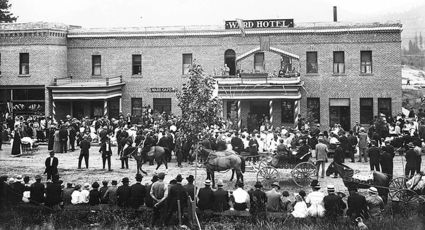Remember When
September 13, 2018

EARLY CELEBRATION - A crowd gathered outside the Ward Hotel (now the Black Bear Inn) for a Fourth of July Celebration in Thompson Falls. Speakers addressed the crowd from the second-story balcony. A second story over what is now Minnie's Montana Cafe served as an annex to the hotel and offered 20 additional rooms for the hotel.
EDWARD DONLAN
Edward Donlan was a pioneer of Thompson Falls and Sanders County. He was a critical figure in the fight between Plains and Thompson Falls as to which town would be the seat of the newly formed county. He owned large amounts of real estate around Thompson Falls which became Donlan's 1st and 2nd additions to the town.
Born to Irish parents in Quebec, Canada, Donlan left home at the age of twelve to work as a teamster in the lumber camps. In 1889 He came to Montana and worked laying railroad track south of Great Falls. He left that for the timber camps of western Montana. By 1895 he owned his own saw mill. He operated a saw mill near Eddy and held extensive land holdings in and around Thompson Falls. He started the Thompson Falls Mercantile Company in town (it was located on the corner of Broad & Main Streets) and held vast amounts of land to the west and east of town. He unsuccessfully tried to entice European immigrants to settle on the flats to the east of town in what his granddaughter called his bid to make Thompson Falls the "Timber capitol of Montana." Failing this, Donlan worked doggedly to make Thompson Falls the county seat for the newly designated Sanders County. In a bitterly contested political fight between Thompson Falls and Plains, the other candidate, Donlan scored a personal victory over J.A. McGowan and heavily Democratic Plains. A compromise plan gave the seat to Thompson Falls, but the first political appointments to Plains people. The naming of Thompson Falls as the county seat ushered in a boom period that continued up to and through the building of the dam at the falls. Donlan played an important role in this as well. He owned several small dams on the Clark's Fork, and there can be little doubt he helped to persuade John Ryan and other members of the future Thompson Falls Power Company to invest here.
While living in Thompson Falls Donlan had the Ward Hotel built. Construction for the Ward Hotel began in September, 1907 and was completed in May, 1908. He named the hotel after his eldest son, Edward. The original design called for 30 sleeping rooms, an office, a bar, a restaurant, and a full basement for a power plant and a laundry room. Jessie R. Pruden did the excavation and foundation work. He employed 7 men to do the stone foundation. They dumped the massive amount of dirt dug up into neighboring streets so to level the grade. Ten carpenters under J.W. Kennedy nailed up the timber frame from lumber supplied by the Graves Creek saw mill. Furniture was purchased from Chicago, and on May 24, 1908 the hotel opened for business.
At the time of its construction, it stood as one of the finest hotels in western Montana. In 1911, a back kitchen area was added and the restaurant expanded. Earlier that year, he started building a nearby two-story brick annex to the hotel which increased its capacity to 50 rooms. Two years later Donlan sold the hotel business to James Rhoades, then mayor of Missoula, and John Scott. Rhoades quickly sold out to Scott who became the first in a series of owners and proprietors with that surname. Donlan ultimately sold the building in 1915. It passed into the hands of the Thompson Falls Improvement Company. They sold in 1922 to C.H. Stanclift who kept it until 1930. A series of owners since, including Katherine Fessler, the First State Bank of Thompson Falls, and the Huff family, have had possession of the property. The name changed from the Ward to the Hotel Thompson in the 1920s, to the Black Bear Hotel in the 1930s and to the Townhouse Hotel in the 1970s.
According to the Montana Historical Society the two story Ward Hotel is a frame structure with a brick veneer resting on a stone and mortar and wood pier foundation. The main (north) façade has eight 1/1 double hung sash windows with wood sills and stone relieving arches. A pair of modern hinged glass doors centered along the façade are covered by a gabled, bracketed hood. Along the left side of the façade two large picture windows flank a recessed entry which is covered by a metal awning. Eight 1/1 double hung windows with wood sills and stone relieving arches are located on the second floor of the primary façade. There is a former door frame on the second story which led to a balcony. This opening has a brick and stone semicircular arch enhanced by stone quoins and decorative stone voussoirs. An attractive and elaborate corbeled brick cornice surrounds the building on the north and west facades. The west elevation, facing Fulton Street, has an entrance and four 1/1 double hung windows similar to the main façade on the first floor. The south façade has a covered entryway and three 1/1 double hung windows on the first floor, with seven 1/1 double hung windows piercing the second story. Two wooden porches, one above the main entrance and one attached to the northeast corner of the structure, were removed at an undetermined date. The east wall adjoins a one story brick addition that originally served as the hotel annex.
Donlan sold Sanders County the lots where they ultimately built the county courthouse and jail and he sold property to the Thompson Falls Power Company to help construct their dam. Donlan continued to buy land around the town and became the leading property owner of city lots. In 1913-1914, after deciding not to run for the legislature again, Donlan began to sell his Sanders County Holdings and moved his operations to Milltown outside of Missoula. Much of the Thompson Falls property went to the Thompson Falls Improvement Company and some to the Thompson Falls Water Company. It is probable that Donlan was a stockholder in each. The land he sold west of town soon became incorporated into the town as Donlan's Additions #1 and #2.
Because of his vast timber and land holdings he was known as "King Donlan." He died in 1952 in Missoula, Montana.








Reader Comments(0)